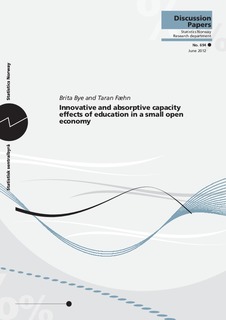| dc.contributor.author | Bye, Brita | |
| dc.contributor.author | Fæhn, Taran | |
| dc.coverage.spatial | Norway | nb_NO |
| dc.date.accessioned | 2019-11-13T10:31:22Z | |
| dc.date.available | 2019-11-13T10:31:22Z | |
| dc.date.issued | 2012-06 | |
| dc.identifier.issn | 0809-733X | |
| dc.identifier.uri | http://hdl.handle.net/11250/2628149 | |
| dc.description.abstract | Evidence points to relatively low supply elasticities for workers skilled for research and development (R&D), which can hamper innovation and growth. Increasing the supply of R&D skills will expand an economy's innovative capacity. A simultaneous effect of increased education, which is particularly important for small, open economies, is to raise final goods producers’ capacity to absorb crossborder knowledge spillovers. In a calibrated endogenous growth model for Norway, we find that increasing the share of highly educated workers has pronounced absorptive capacity effects that partially crowd out R&D-based innovation. Both innovative and absorptive capacity expansions contribute to higher growth and welfare. | nb_NO |
| dc.description.sponsorship | Norwegian Research Council (BITE, project no. 177729/V10) | nb_NO |
| dc.language.iso | eng | nb_NO |
| dc.publisher | Statistisk sentralbyrå | nb_NO |
| dc.relation.ispartofseries | Discussion papers;694 | |
| dc.subject | JEL classification: O30 | nb_NO |
| dc.subject | JEL classification: O41 | nb_NO |
| dc.title | Innovative and absorptive capacity effects of education in a small open economy | nb_NO |
| dc.type | Working paper | nb_NO |
| dc.description.version | publishedVersion | nb_NO |
| dc.subject.nsi | VDP::Matematikk og Naturvitenskap: 400::Matematikk: 410::Statistikk: 412 | nb_NO |
